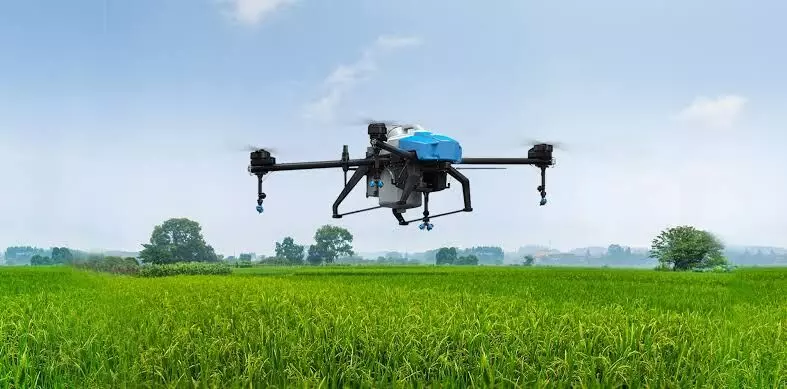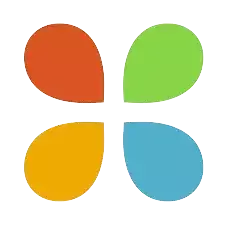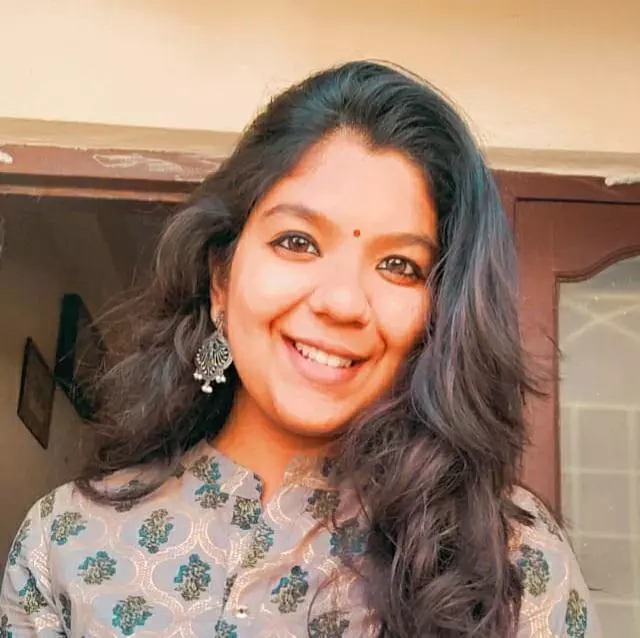Agricopter drones to revolutionise farming, generate lucrative jobs
Hyderabad-based company, has conceived the idea and manufactured India's first precision-agriculture drones which are used in farm operations.

Marut drones, a Hyderabad-based company, has conceived the idea and manufactured India's first precision-agriculture drones which are used in farm operations.
Prem Kumar Vislawath, founder of Marut Drones, identified that farmers did not adopt any new technologies after the 'green revolution', in the 1960s. When he visited his native Kandukur village in Telangana, he saw that crops were destroyed due to scarcity of water. When tractors were used for working in the field, they trampled the crop. Farmers couldn't spray pesticides in crops like the sesame, which had thorns, leading to pests destroying an entire crop. He identified that drones could be the solution to all these problems and much more.
In an exclusive interview with 'NewsTap', Prem explained how agri-drones would revolutionise the way of farming in India. The Government of India offers subsidies to farmers of different classifications for the purchase of drones.
When did you feel that drones are the solution for the problems confronted by farmers, how did you begin to work on it?
To turn this idea into reality, Marut Drones began research, to obtain scientific data of different uses and use cases of drones in agriculture. Marut Drones is the first enterprise in the country to get exemptions from Director-General of Civil Aviation (DGCA) and Airports Authority of India (AAI), in 2019, after which they set precedence for the research.
Wasn't there any resistance from farmers for using new technology?
Marut drones, in collaboration with the Professor Jayashankar Telangana State Agricultural University (PJTSAU), set the stage for research in Telangana. We together carried out research on how farmers could use drone technology to spray pesticides or irrigation. We saw that the farm and the farmers were not resistant to the use of drones.
The farms showed immediate improvement, and this instilled confidence in farmers. We began to scientifically understand the crop's behaviour and derive solutions to farming related problems. They noted points like the days on which the pesticides needed to be sprayed, the height above the crop from where the pesticide could be sprayed, which nozzles to use for spraying on different types of crops, the impact of the drones on flora, fauna, soil and water, the amount of water and pesticide being saved, etc.
How did you get the scientific knowhow to work on agricultural operations?
The Director of Research in PJTSAU Prof. Jagadish and his team have provided the end-to-end knowledge of crop patterns, seasons, pests, productivity, yields, and need analysis to find solutions to the problems plaguing the crops.
As the agricultural research teams worked closely with the technology teams of Marut drones, we jointly picked seven different crops which were largely grown in seven different climatic/soil regions – paddy in Rajendranagar university farm and Nalgonda, cotton in Warangal, red gram in Tandur, soybean in Jagityal, groundnut in Palem, sesame in Tandur and Toor dal in Adilabad.
How did drone technology come in handy?
Research showed that the multi-utility device - drone - could be used for sowing seeds, or transplantation, fertiliser spraying, pollination and fumigation to disinfect the crop. Drones can also be used for crop monitoring. Multispectral sensors installed in the drones help check for pests and growth in the crop. The sensors give out an image of the entire field to the farmer without the farmer physically monitoring the plants.
The research was sent to the Central Insecticide Board and Indian Council for Agricultural Research (ICAR) after which it was approved by the Union Agricultural Department.
Why agri-drones for farming?
On an average, a crop requires pesticides at least once in two weeks. Traditional methods of spraying these chemicals were a huge health hazard to farmers. It caused the increase of cancer and TB cases amongst farmers. Drones eradicate the contact between the farmer and the chemical, protecting their health.
Another challenge faced by farmers was that the chemical, if not spread precisely, destroyed the crop. Drones help in spraying the pesticides uniformly over the farm, saving the wastage of product as well as keeping the crop safe.
Farmers could also monitor their crop through drone sensors which project an image of the entire crop. They can identify areas where there are pests and precisely spray pesticides on the required area. Research revealed that 80% of chemical usage was reduced with the usage of drones. Previously, farmers used 50-100 ltr of water and chemicals and the usage of drones decreased it to just 8-10 ltr due to 'precision farming'.
The yield would also be sold at a higher rate as the amount of pesticide would be less in the produce and the quality of food (in case of food crops) would remain high.
What are the types of drones?
Agri-drones can weigh from 250 gm to 150 kg. Quality Control of India, which is roped in by DGCA for drone certifications, authorised the use of 25 kg drones as the best size drones for farming.
The drones are classified according to their capacity to lift weight.
250 gm - nano drones
250 gm to 2 kg- micro drones
2 kg to 5 kg - mini drones
5 kg to 25 kg - small drones
25 kg to 150 kg - medium drones.
The use of medium drones in agriculture is yet to be certified by the DGCA.
Who can operate these drones?
Operating drones is not rocket science. Any person who has cleared class 10 and possesses a passport could go for a one-week training programme and get a drone pilot licence, which would be valid for 10 years. The licence will not only authorise the pilot to operate agri-drones, but to operate any drone. In Telangana, training is being given at the Telangana State Aviation Academy, for operating 25-kg drones (small drones).
To operate drones, one must take authorization at least 24 hours before operation. They must also be sober for a minimum of 8 hours before operating. Agri-drones do not have authorization to fly over restricted areas, government properties, army areas or private residences.
To take technology to masses, PJTSAU and Marut have also worked together to set up a Remote Pilot Training Organisation (RPTO) to train state's farmers to operate drones for safe, reliable and efficient usage of them in agriculture.
What opportunities would it create in terms of jobs?
In Telangana, over 25,000 drones are needed. Each drone would be operated by a pilot, and a co-pilot . This would create 50,000 job opportunities in the State for the youth.
Youths from farmer families are not interested in agriculture since there were no modern methods being adopted. However, operating drones would enable them to work on their own farm-lands, from their own towns or villages. Drone operators can make upto Rs 10,000 per day and Rs 2 lakhs per month by working on just 20 acres for just 20 days in a month.
Who put subsidies on the drones?
The Union Ministry of Agriculture has introduced subsidies on drones after studying the research and use cases of drones in agriculture. The subsidies are implemented by the States.
Krishi Vigyan Kendras, an integral part of the National Agricultural Research System, get a 100 percent subsidy on drone purchases. Farmer Producer Organisations (FPOs) get a 75 percent subsidy, upto Rs 10 lakhs, on drones while individual farmers get 40-50 percent subsidy.
How did Marut Drones grow with this research process?
Marut has also worked with the World Economic Forum, Emerging Technology Wing and PJTSAU in developing varietal screening of paddy in Karimnagar district under the A14Al project which were recognised by various stakeholders across the country. The outcomes could become a critical tool in policy making and matching supply and demand.This is bound to have a huge impact on Telangana's farmers with timely interventions, reduction in crop losses, higher productivity, lower costs, higher profits getting them out of debt traps.
PJTSAU and Marut Drones have also filed patent applications for direct seeding drones developed under this collaboration and many more patents and papers are in progress.



